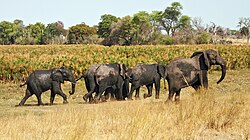Bwabwata National Park
Bwabwata National Park is in Caprivi in Namibia. It is an important migration route from Botswana to Angola for African elephant and some other game species.
Understand
[edit]The park covers 6,274 km² (2,422 sq mi) It is an unusual Protected Area as about 5,500 people live in the park. The Namibian government involves park residents and neighbours in planning and managing the park.
The park is 40 km north to south and 190 km from west to east. Bwabwata is situated in the Caprivi and Kavango regions, extending along the Caprivi Strip. It is bounded by the Okavango River to the west and the Kwando River to the east. Angola lies to the north and Botswana to the south.
At either end of the park are small settlements – Kongola in the east and Divundu in the west.
The park is largely unfenced, but the southern boundary with Botswana has three veterinary standard fences. These prevent the spread of cattle diseases, such as foot-and-mouth disease.
History
[edit]Landscape
[edit]The largest of the parks in Caprivi, Bwabwata National Park covers the whole of the Caprivi strip with a somewhat unique landscape. It is situated on an old dune system which means that there are a number of drainage lines running north west-south east across the whole length of the park.
Flora
[edit]
The vegetation is a mixture of riverine forest, teak forest, acacia fringe woodland on the edge of the drainage lines and open grassland.
Bwabwata is located in the Tree and Shrub Savanna biome. Vegetation types include North-eastern Kalahari Woodland, Caprivi Mopane Woodland, Riverine Woodlands and Islands, Okavango Valley, Caprivi Floodplains. The landscape consists of low vegetated sand dunes with old drainage lines (Omiramba) in between.
Fauna
[edit]
Bwabwata forms a crucial trans-boundary link for wildlife movement between Angola, Botswana, Namibia and Zambia.Several rare large mammal and bird species are found in Bwabwata. Elephants regularly move between Namibia, Angola, Botswana and Zambia. Other species found are Cape buffalo, hippopotamus, roan antelope, sable antelope, tsessebe, zebra, wildebeest, common reedbuck, red lechwe, sitatunga and crocodile. Main predators are lion, leopard, cheetah and spotted hyena.

The Mahango Area and Kavango River in western Bwabwata are listed as an internationally Important Bird Area supporting globally threatened species and is an avian diversity hotspot. Species include black-winged pratincole, slaty egret, wattled crane, African skimmer, African pygmy-goose, coppery-tailed coucal, white-backed night heron, rufous-bellied heron, Allen's gallinule, Dickinson's kestrel, black-faced babbler, swamp boubou, collared palm thrush, Meves's starling, southern ground hornbill, barred owlet, Bennett's woodpecker, wood owl, various warblers and cisticolas.
Climate
[edit]Get in
[edit]The main road between the towns of Rundu and Katima Mulilo, the Trans-Caprivi Highway (B8), runs through Bwabwata, linking Namibia to Botswana, Zambia and Zimbabwe. A minor road (C48) dissects Mahango in a north-south direction and connects Namibia to Botswana.
Fees and permits
[edit]Visitors travelling off the main road need a permit and must drive only on designated roads. Several sandy roads, suitable for all-wheel drive vehicles, are found near the Kwando and Okavango rivers.
Get around
[edit]Bwabwata has a national route running the length of the park (the B8) with 120 km/h speed limits. The road is unfenced, so watch your speed and avoid driving at night time if possible. Many animals are killed each year by vehicles, including endangered species such as wild dogs, which are very inquisitive of vehicles.
Tour operators offer game drives, boat trips and walks in the park.
See
[edit]- 1 Popa Falls.
Wildlife
[edit]Expect to see buffalo, hordes of elephant, lion (which are making a big comeback in the area), leopard, African wild dog, sable, roan, giraffe, and the usual impala, kudu, and zebra.
In the rainy season, the drainage lines fill with rain that sits in natural pans, providing drinking water for game long into the dry months. Once the water evaporates completely, the game moves to the Kwando and Kavango rivers. If you are staying on the riverfront, the best time of year for seeing game is July-November.
Do
[edit]When there is water in the pans there is an almost unexplored road network (most of which is old routes created by the South African military) in the park interior.
Buy
[edit]- 1 Hombe Supermarket and Take Away, ☏ +264 66 259 048. 8AM–6PM daily.
Eat
[edit]Drink
[edit]Sleep
[edit]There are several lodges are outside Bwabwata on its borders.
Lodging
[edit]- Divundu Guest House (in Divindu), ☏ +264 66 259 031.
- 1 Popa Falls Resort (near Popa Falls), ☏ +264 66 259 023.
- Shametu River Lodge and Campsite, ☏ +264 66 259 035.
Camping
[edit]Bwabwata has three community-operated campsites within the park, namely Nǁgoabaca, Nambwa and Bum Hill. Local communities, organised into communal area conservancies, earn revenue from these campsites.


 Français
Français Italiano
Italiano




